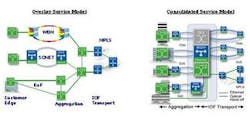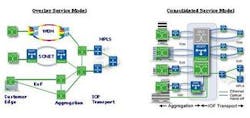Managing Ethernet in the metro core
There are two primary ways to deploy Ethernet services. One is clearly more efficient than the other.
Ian Hood
Mahi Networks
Many service providers are focused on delivering a greater breadth of high-margin services, lowering their overall cost of business, and preparing their networks for strategic expansion. The ability of service providers to deliver Ethernet services for their business customers will be a key factor in their success in a highly competitive marketplace.
There are a number of values that Ethernet services provide to the end customers: simplicity of the access point, greater number of service choices, and elasticity of bandwidth, to name three. At the same time, these end customers place a variety of demands upon their service providers: lower cost per megabit, faster turnaround time on service orders and bandwidth changes, and transparent delivery of these services independent of the location. The end customer wants to view data services like a water or electric utility -- pay for what they use with the ability to change the data rate at will.
From an end customer connectivity perspective, two Ethernet service types have emerged as defined by the Metro Ethernet Forum (MEF) and the IETF working groups:
1) Ethernet Line Service (E-LINE) -- the end customer is provided a point-to-point Ethernet Virtual Connection (EVC) between its sites. The IETF has defined this service type as Virtual Private Wire Service (VPWS).
2) Ethernet LAN Service (E-LAN) -- the end customer is provided multi-point or any-to-any Ethernet connectivity between its sites. The IETF has defined and described this service type as Virtual Private LAN Service (VPLS).
The first approach is to deploy primarily Ethernet switching elements in an overlay model to support any of the E-LINE or E-LAN services. In this model, the underlying transport elements do not directly participate or terminate any of the services. The primary benefits of the overlay model are that the network elements are relatively simple, have known operational models, and are deployable with existing technologies. However, this approach leads to the deployment of a large number of devices, and a significant amount of duplicated inter-nodal connections to the transport equipment. In addition, there are costs associated with a separate management infrastructure to say nothing of the cost of deploying dedicated fiber and wavelengths.
The second approach employs a consolidated service model that employs packet-aware transport technologies to participate in the deployment of Ethernet services. In this approach, one benefits from a smaller number of network elements, common service management, and more efficiency in the use of legacy SONET/SDH transport infrastructure.
Another factor in the approach to delivering Ethernet services is the technology employed to identify and separate traffic from the end customers. The enterprise business customers are quite familiar with employing IEEE 802.1q virtual LAN tags to separate business units or departments. IEEE 802.1q VLAN translation and draft IEEE 802.1ad provider provisioned bridges (i.e., VLAN stacking) employ the notion of a service provider tag to separate customer traffic. Both of these methods add some complexity to the Ethernet network elements while increasing the scalability of the Ethernet service network.
Alternatively, the IETF has defined a method within the VPLS framework to encapsulate the Ethernet packets in MPLS with a service label to uniquely identify the customer traffic flows. VPLS label technology provides a significant increase in scalability as well as the ability to transparently extend Ethernet services across an IP/MPLS based core network.
Ethernet in carrier networks
Although Ethernet is a very cost-effective LAN media within an enterprise business, a number of its attributes must be carefully controlled in the service provider network (e.g., address learning, delivery and control of broadcast traffic, and maintaining loop-free topologies). Standard IEEE 802.1 Ethernet bridging mechanisms support a finite number of E-LAN endpoints and have no inherent traffic engineering capabilities. However, there are enhancements to the IEEE 802.1 control protocols that improve Ethernet facility recovery times and can limit broadcast traffic.
Ethernet services based upon the IETF-defined VPLS technologies allow the service provider to spread its deployment effort across multiple network elements. The customer edge devices can perform the address learning and VPLS encapsulation while the aggregation devices can create the multi-point tunnels that emulate the E-LAN.
However, hierarchical VPLS technology is not free and does add significant complexity to the management of Ethernet services within the service provider infrastructure. The hierarchical aspects of VPLS may be applied to the data, control, and management plane to ease the provisioning and deployment complexity. Traffic engineering extensions to RSVP provide efficient and reliable path selection with faster link recovery, dynamic learning of E-LAN members provides fast provisioning and zero disruption, and VPLS service labels are transparently extensible to other VPN services (e.g., ATM, Frame Relay, and IP).
Figure 2 illustrates an integrated approach to managing Ethernet service deployments in the metropolitan network.
Consolidating the service delivery over packet-aware transport infrastructure allows the service provider to make pragmatic choices in technology and service deployment. Multi-service aggregation and multiplexing capabilities improve bandwidth efficiency in the access networks with Generic Frame Procedure (G.7041), Virtual Concatenation (G.707), or Resilient Packet Ring (IEEE 802.17 RPR). End-to-end traffic management (e.g., WRED, CAC) ensures the fair treatment of customers according to their contracted service-level agreement (SLA). Service providers can choose the amount of participation by the intelligent packet-aware transport devices to simplify the deployment of their Ethernet and value-added data services. The ultimate goal is to provide a greater number of profitable service choices to the end customers independent of the underlying technology at flexible price points to any of their locations.
Through the use of common mediation mechanisms, service providers can simplify their transport infrastructure (i.e., less network elements and interconnections). Each metropolitan domain will vary in terms of Ethernet service penetration, inherent transport infrastructure, and bandwidth costs. As with many decisions faced by business customers and service providers today, there are no definitive choices that cover all potential cases. Service providers must engage the equipment vendors to perform detailed business and cost model analysis that includes fiber availability, capital equipment, and operational factors. As a result, one is able to deploy technology in a success-based manner that is flexible and can easily be adapted to support multiple services efficiently and reliably while consciously controlling all aspects of network and operational complexity.
Ian Hood is senior product line manager at Mahi Networks Inc. (Petaluma, CA).

